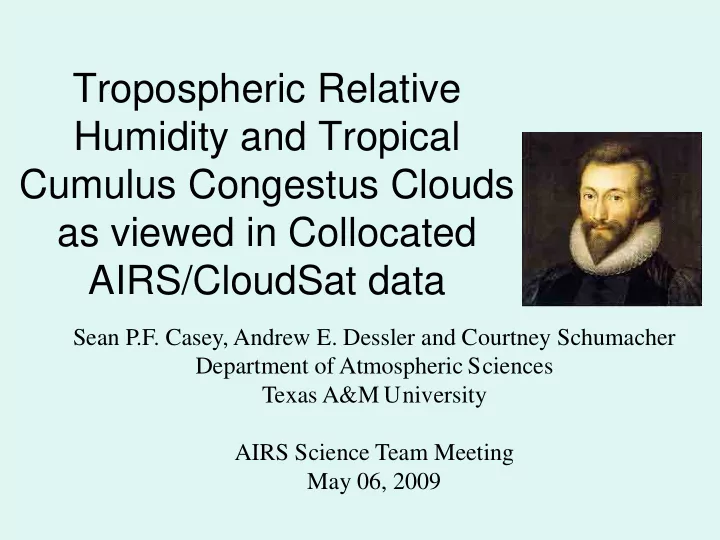

Tropospheric Relative Humidity and Tropical Cumulus Congestus Clouds as viewed in Collocated AIRS/CloudSat data Sean P.F. Casey, Andrew E. Dessler and Courtney Schumacher Department of Atmospheric Sciences Texas A&M University AIRS Science Team Meeting May 06, 2009
Johnson et al. (1999)
Kikuchi and Takayabu (2004) found distinct MJO stages in convection over the west Pacific, including: • Shallow convection stage • Low cloud-top heights • Low middle and upper tropospheric humidity • Developing stage, dominated by congestus • Cloud-top heights predominantly in the middle troposphere • Midtroposphere moistening • Mature stage, dominated by deep clouds • High cloud tops • High middle and upper tropospheric humidity
The Big Question: What is the interplay between tropical convection and atmospheric relative humidity? Implications for: • Water Vapor amounts/feedbacks • Cloud parameterizations within GCMs • Many more fields of study
The A-Train CloudSat provides a 2B-GEOPROF-LIDAR product which allows easy use of collocated CloudSat/CALIPSO data to view all clouds, from subvisible cirrus to deep convection Stephens et al. (2002)
New AIRS/CloudSat collocated product CloudSat footprint • Collocates 172 variables of AIRS L2 Standard data with CloudSat 2B- GEOPROF • January 2007 completed; used here • Connects relative humidity values to observed clouds AIRS footprint
Advantages/Disadvantages of: AIRS CloudSat • Wide swath width • Nadir-only view • ~45 km 2 footprint • ~1 km 2 footprint • Maximum of two • Total column view of cloud layers clouds available Casey et al. 2007
Determining Convective Features CTH 1. Cloud identified as “cloud certain” (cloud mask = 40) for entire depth of cloud Maximum reflectivity ≥ 10 dBZ 2. (proxy for convection [Luo et al. 2008]) 3. CALIPSO-measured cloud-top height (CTH) within 1 km of Cloudsat-measured cloud-top height (proxy for optically-thick cloud [Luo et al. 2008])
However, Cloudsat provides a snapshot of cloud height Me, age 11 My grandmother
However, Cloudsat provides a snapshot of cloud height Me, today
Luo et al. 2009 Transient Congestus Terminal Congestus
Conversion from Snapshot to Final Cloud Heights using Geostationary Satellites • NCEP/AWS Global Geostationary data range Infrared Geostationary Composite (from GHRC) • Combines geostationary satellites (with exception of GMS; data gap around 70 E) • 14-km resolution, 30- minute time intervals CloudSat-observed cloud
Geostationary Composites Minimum Brightness Temperature T B (assumed final CTH) Time Brightness Temperature at time of CloudSat overpass Using this, we noted that ~25% of observed congestus are transient.
Including AIRS Data • Using observed geometric heights and minimum T B , separate identified convective features into: – Shallow – Terminal Congestus – Transient Congestus – Deep • Determine mean RH in the presence of each cloud type – Only regions where Qual_H2O=0 or (Qual_H2O = 1 and PBest > 600 hPa)
• Notable difference in terminal, transient congestus curves • Virtually no difference between transient congestus, deep curves…because they describe the same cloud!
Shallow Convection Stage: • Moist below 850 hPa • Dry middle, upper troposphere
Developing (Congestus) Stage: • RH increases to 60% at 600-700 hPa level • 10% increase in upper troposphere
Mature (Deep) Stage: • Further moistening of atmosphere above 600 hPa • Little change below 600 hPa from developing (congestus) stage
With Just One Month (and a lot of quality flags) • Demonstrated the need to separate terminal from transient congestus clouds – Transient congestus = deep clouds • Identified cloud types with given relative humidity profiles (in agreement with Kikuchi and Takayabu [2004])
Future Work An expansion of the AIRS/CloudSat collocated dataset will allow for a variety of other studies, including: • Seasonal, regional variations of – Cloud amount – Cloud type – Relation to upper tropospheric relative humidity • Backtrajectory analysis of sources of drier air aloft, similar to midtropospheric dry air analysis in Casey et al. [2009; in publication]
Any Questions?
Recommend
More recommend